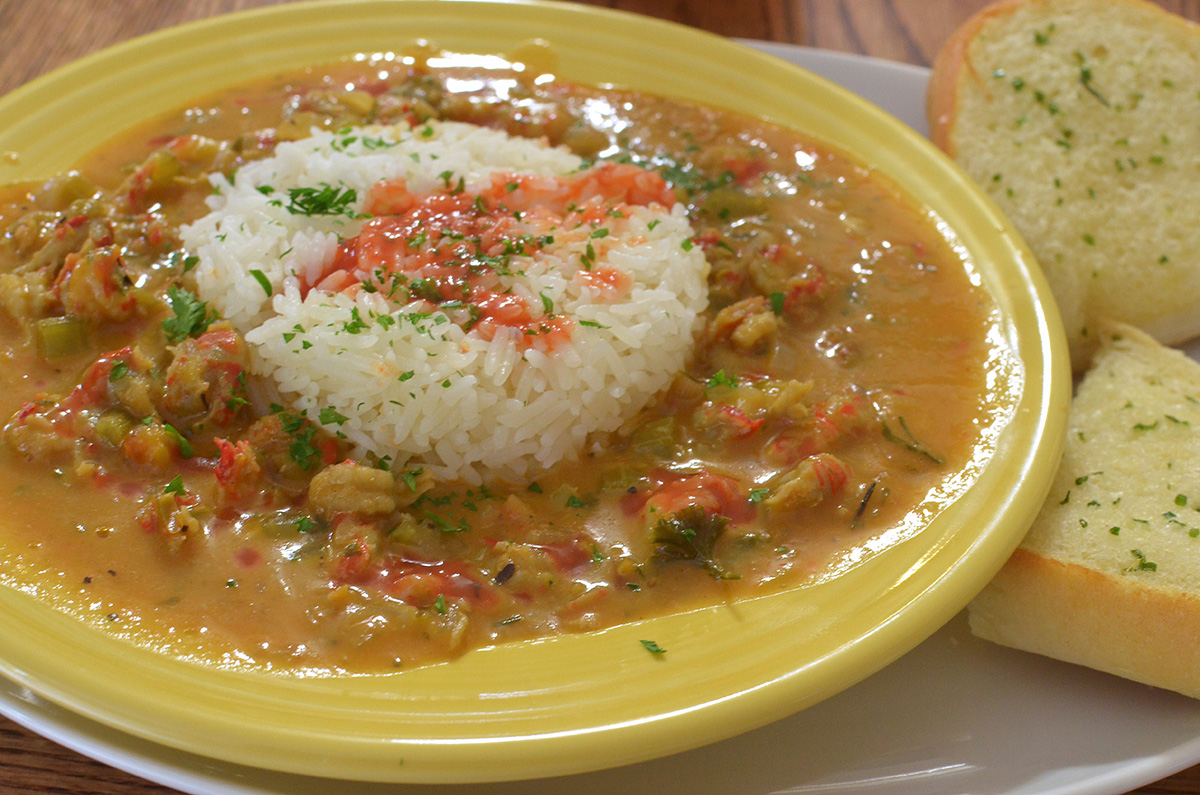Crawfish Étouffée
One of Louisiana’s renowned dishes, crawfish étouffée is typically comprised of crawfish cooked in its own juices with other seasonings and served over rice.

Jeffreyw via Wikimedia Commons
A plate of Crawfish Étouffée served with white rice, 2012.
Crawfish étouffée is a dish made with the state’s most well-known crustacean cooked in its own juices and other seasonings and served over rice. With a name coming from the French word for smother (étouffer), crawfish étouffée is a relative newcomer on the list of Louisiana recipes, dating only from the first half of the twentieth century.
Breaux Bridge residents contributed to its initial popularity. There, Yolie and Marie Hébert, daughters of the owners of the Hébert Hotel in the 1920s, served what they called a crawfish courtbouillon, which usually in Acadiana is a tomato-based fish stew. They passed the recipe to Aline Guidry Champagne, a member of the family that owned Guidry’s Place and the Rendezvous Club and Restaurant, both located first in then-unincorporated Henderson. In the late 1940s, Champagne changed it, leaving out tomatoes, garlic, and celery. She was cooking her simple dish when favorite customers came into the restaurant kitchen. Since they were speaking Cajun French, she told them, “J’étouffe les écrevisses.” They not only ordered what she was making but began bringing others who requested it. Crawfish étouffée was officially added to the Rendezvous Club menu in 1950. When Pat Huval bought Guidry’s Place in 1952 (later changing its name to Pat’s Restaurant), crawfish étouffée became a favorite of visitors from far and wide, including governors Earl Long, Jimmie Davis, John McKeithen, Edwin Edwards, and Kathleen Blanco. Lafayette also became known for crawfish étouffée, with Don’s Seafood Inn (later Don’s Seafood and Steak House) acting as a lead promoter of the region’s cuisine in general. In 1958, a cookbook published by the restaurant entitled Don’s Secrets contained one of the first printed recipes for crawfish étouffée.
Over the years, the dish became thicker and graced again with celery and garlic. Cajun crawfish étouffée is also often made with butter, margarine or lard, onions, bell peppers, celery, and seasonings. Experienced cooks know that crawfish “fat” (part of the crawfish head and a liver-like organ called the hepatopancreas) is essential. A crawfish stock, made from shells of the crustacean, also boosts flavor.
In Creole enclaves, cooks usually insist on a butter-based roux with tomatoes added to the same holy trinity of vegetables: onions, bell peppers, and celery. While sometimes compared to gumbo, crawfish étouffée is sweeter, and its sauce is closer to a gravy than a stew. Singer Johnette Downing describes it in her song “Crawfish Étouffée,” on her album Swamp Romp.
Many South Louisiana residents encouraged recognition of the dish as they rallied to make the crawfish the official Louisiana crustacean. The recipe’s rise to popularity in the 1970s coincided with the LSU Agricultural Center’s increasing promotion of crawfish cultivation in rice fields. Eventually, shoppers could find pond-raised crawfish already peeled and wrapped in plastic.
Celebrity chefs also contributed to crawfish étouffée’s popularity. They tend to emphasize that it can be cooked quickly, faster even than rice. The roux in the New Orleans recipe is a light one, not requiring constant stirring. Variations on the dish include adding tomato paste, cornstarch rather than flour in a roux, and shrimp soup to replace crawfish fat. Other cooks mention long hours of boiling, cleaning, pulling off shells, chopping vegetables, and making a roux. Some cooks have gone farther afield. Twenty-first-century Jazz Fest–goers can find Patton’s Caterers of Chalmette serving a crawfish sack, which is crawfish étouffée spooned into a crêpe that is tied up into a bundle and deep fried. Other modifications call for crawfish étouffée served over crawfish cornbread instead of rice; low fat, gluten free ingredients; or shrimp, catfish, and even chicken as the main ingredient.
